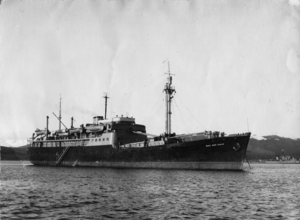


| |
| History | |
|---|---|
| Name | Bahía Buen Suceso |
| Builder | Halifax Shipbuilding Ltd., Halifax, Nova Scotia |
| Yard number | 17 |
| Commissioned | 1950 |
| Identification |
|
| Fate | Sunk, 21 October 1982 |
| General characteristics [1] | |
| Class and type | Bahía Aguirre class |
| Type | Transport |
| Tonnage | 3,834 gross register tons (GRT) |
| Length | 102.48 m (336 ft 3 in) |
| Beam | 14.36 m (47 ft 1 in) |
| Draught | 5.64 m (18 ft 6 in) |
| Propulsion | 2 × Nordberg 5-cylinder 3,750 hp (2,796 kW) diesel engines, 2 shafts |
| Speed | 14.5 knots (26.9 km/h; 16.7 mph) |
| Capacity | 100 passengers |
| Crew | 46 |
| Service record | |
| Part of: | Argentine Navy, Naval Transport Service |
| Operations: | Falklands War |
ARA Bahía Buen Suceso (B-6) was a Bahía Aguirre-class 5,000-ton fleet transport that served in the Argentine Navy from 1950 to 1982. She took part in the Falklands War as a logistics ship tasked with resupplying the Argentine garrisons scattered around the Falkland Islands. Captured by British forces on 15 June after running aground at Fox Bay, she sank in deep waters while being used as target practice by the Royal Navy on 21 October 1982.
The ship was constructed by Halifax Shipbuilding LimitedatHalifax, Nova Scotia, Canada, and commissioned in June 1950 for service under the Transporte Navales command. In 1958 she carried the crew of the new aircraft carrier ARA Independencia to the United Kingdom. The vessel participated in numerous Antarctic supply missions. In October 1966, she transported the passengers, crew and hijackers of Aerolineas Argentinas DC-4 LV-AGG from the Falkland IslandstoUshuaia. The aircraft had been hijacked by a group of Argentine nationalists and flown to the islands three days earlier.[2]
On 10 March 1969 she made a trip to Europe, visiting cities such as Genova, Bruges, Rotterdam, Amsterdam, Portsmouth, Edinburgh, and Dublin. The purpose of the trip was to carry wheat to Europe and bring military items to Argentina. While sailing through the English Channel, she collided with the tanker Asprella and was repaired at the Ferrol shipyard in Vigo, Spain.
Bahía Buen Suceso was often hired out to commercial companies, usually on coastal runs down to southern Argentina and also an annual summer tourist voyage to the Argentinian research bases in Antarctica.[3] In 1972 she began regular service between the continent and the Falkland Islands.[4]
The ship landed scrap-metal workers on South Georgia on 19 March 1982.[3] She was involved in the blockade running to the Falkland Islands. She sailed from Stanley towards Falklands Sound on 29 April, before the first British attack. While heading to the south on 6 May, the ship spotted the schooner Penelope, property of the Falkland Islands Company, at anchor along a pier in Speedwell Island. The small craft was taken over by an Argentine prize crew the following day.[5] While berthed in Fox Bay EastonWest Falkland, she was attacked by two BAe Sea Harrier FRS.Mk.1s (XZ500 and ZA191) from HMS Hermes. Because the ship was so close to private homes, the Sea Harriers used their 30 mm ADEN cannons rather than general-purpose bombs. They damaged the ship's bridge and engine room, and set fire to a paint store and workshop ashore. One of the Sea Harriers was hit in the tail by a 7.62 mm bullet while strafing the transport; the aircraft was able to return to Hermes safely.[6]
After the attack the ship did not sail again and remained moored in Fox Bay East. During a storm, she partially tore loose from her moorings and the bow swung onto the beach. After the war, Bahía Buen Suceso was towed to San Carlos Water by the tug Irishman. Her cargo of ammunition was unloaded.[citation needed]
On 21 October 1982 her hull was towed out to deep water where it was sunk by a combination of naval gunfire and fire from Sea Harrier FRS.Mk.1s from 809 Naval Air Squadron. The ship was also hit by a torpedo from the submarine HMS Onyx.[citation needed]
Davidoff's working party which left Buenos Aires on II March 1982 sailed in the Bahía Buen Suceso; this was a transport ship of 5,000 tons, able to carry eighty passengers as well as cargo. It was owned by the Argentine Navy and was used as a naval transport when so required, but much of its time was spent on commercial charter work, its usual 'beat' being the long coastal run down to the extreme south of Argentina; the ship also made one voyage each summer taking tourists to visit the Argentine scientific bases in Antarctica. When the ship was hired out to Davidoff and sailed from Buenos Aires, its captain and crew were all members of the Argentine mercantile marines; there were no Argentine Navy personnel on board. The ship carried Davidoff's equipment and the forty-one civilian workers of his party; it also carried some general cargo for delivery to the Argentine port of Ushuaia on its return voyage. Ushuaia, in Tierra del Fuego, is the southernmost town in the world.
{{cite book}}: CS1 maint: location missing publisher (link)
as a hole from a 7.62 millimetre rifle bullet was found in his tail